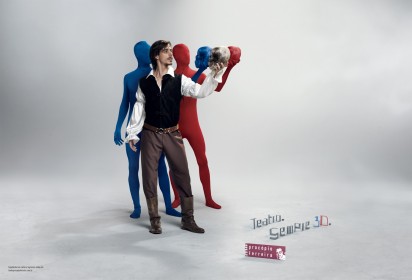Panting for Breath on a Virtual Shore
Posted in: UncategorizedWe are no longer homo sapiens: we’re cyborgs.
From Adbusters #106: Mental Breakdown of a Nation

VALERIE BELIN / EDWYNN HOUK GALLERY / NEW YORK
Each day, our porous skin opens less and less to fresh air, sunlight, the touch of others, the smell of pine, rain, compost, and manure . . . and instead we find ourselves hunched over machines in the standard posture of reverence, bowing our heads to the humming and warm computer-pets that rest on our laps or in our palms.
It took millions of years of evolution for life on earth to move out of the oceans onto land, where our phylogenetic ancestors gasped for their first breaths on a pebbled beach. Now, some 590,000,000 years later, we find ourselves panting for air on a virtual shore.
We’re embarking on the second greatest migration in the history of life of earth, from the physical world into virtuality. In the span of just one generation, we’ve been completely wooed over by the entirely-cerebral and entirely-virtual adventures accessed when our fingertips apply light pressure to a plastic “mouse.”
Today, teenagers in America spend seven hours on a screen each day, 11 if you include multitasking hours: this is more time than human beings spend doing anything else, including sleeping. Teenage girls send over 3,700 texts a month, even 12 year old girls have over 500 Facebook friends, 250 of which are total strangers to them. The combination of online sexual coercion in chat rooms and cyber-bullying drives a young girl, Amanda Todd, to suicide. And just think, it’s only been thirty years – even less for most – since the world wide web came into our lives.
Initially, the internet was created by and for the military. For several decades after that it was used only in emergencies, and later on by computer engineers, IT professionals or for the back-end of certain businesses and institutions. But then came the commercialization of the internet in 1995, the invention of search engines in the mid-late 90s, Google in 1998, BlackBerry in 2001, Facebook in 2004, and the first iPhone in 2007. These events have all occurred in less than twenty years. The most current trend, the personal computer revolution – where everyone, everywhere, is online, nearly all the time – is very new, less than five years old. It is this latest trend which has impacted our lives most dramatically, and in a remarkably unprecedented way if you consider the vast timeline of our development on planet Earth. We are no longer homo sapiens: we’re cyborgs.
Our common understanding of cyborgs are hollywood clichés: rogue robots with human skin pulled taut over sleek metal wiring, and ON/OFF buttons tucked away in thigh or knee crevasses. But we don’t have to wait until we embed chips beneath our skin, nor till we get Google Goggles as contact lens glued to our eyes, to earn our status as cyborgian. As Donna Haraway famously suggests, we are entirely cyborgs just as we appear now – with smart-phones tucked snugly in our pockets for every minute of every waking hour, held as close as possible to our skin in a hard-to-access area, much like a sacred amulet was once worn around one’s neck in a burlap pouch.
In her Cyborg Manifesto, Haraway collapses the boundaries between human/animal, and human/machine, suggesting that there is as much artifice as there is “nature” in human nature. Our cyborgian condition was not begot by some sinister mutation, rather, we are as vitally and ineradicably entwined with machines as we are with the bacteria in our intestines. As Marshall McLuhan said: “we create machines in our own image and they, in turn, recreate us in theirs.”
Years before the techno-prolifia we live in today, McLuhan wrote an eerie forecast that has perhaps now come true: “Man would become…as it were, the sex organs of the machine world, as the bee of the plant world, enabling it to fecundate and to evolve ever new forms. The machine world reciprocates man’s love by expediting his wishes and desires, namely, in providing him with wealth.”
The bond between man and machine indeed gleams of eroticism. Technically speaking though, this relationship is an endosymbiotic one (a reciprocal relationship where one of the beings lives within the body of the other, merging with it). But is it us who live inside the machine, as it’s sex organs, or does the machine live inside us? Contrary to McLuhan, Freud believed the machine lives on us, as an appendage that has enabled us to become God-like. We’re omnipotent, since we’ve overcome nature where we can; and thanks to Google, we feel omniscient. In 1929, Freud wrote in Civilization and its Discontents:
Man has, as it were, become a kind of prosthetic God. When he puts on all his auxiliary organs he is truly magnificent; but those organs […] still give him much trouble at times. Future ages will bring with them new and possibly unimaginably great advances in this field of civilization and will increase man’s likeness to God still more. But in the interests of our present investigation, we will not forget that present-day man does not feel happy in his God-like character.
Generations before tamagochi, Facebook and iPads, Freud sensed that there was something primordial being forsaken as man became more and more civilized, and he warned that the prevalent disavowal of our animality would have costs – psychically, physically, socially, erotically.
Today’s most popular gadgets – those palm-sized avatars of hyper-activity and hyper-connectivity – are precisely so seductive because they compensate for the physical, social and erotic loses that technological advances bring. Every ding, tweet, ring, and vibration promises a social, sexual, or professional opportunity. And in less than a decade, our brains have been reprogrammed to respond to these dings, tweets, rings and vibrates with rushes of dopamine, adrenaline and other stimulating neurotransmitters, such that our brains on smart-phones look, on an MRI scan, identical to those of an addict on drugs. The internet’s effects on the brain is the subject of Nicholas Carr’s bestseller, The Shallows: What the internet is doing to our brains, which was nominated for a Pulitzer Price. The latest studies in neuroscience confirm Carr’s suspicions that the internet is a detriment to cognition, concentration, contemplation and psychological health. These studies are finding that what’s most addictive about the internet is not the technology itself, nor the content, but these jolts of energy we get from habitual use of internet applications, which foster and promote compulsive behaviour.
Peter Whybrow, the director of the Semel Institute for Neuroscience and Human Behavior at UCLA, explains that “the computer is like electronic cocaine,” instigating cycles of mania followed by periods of depression. “There’s just something about the medium that’s addictive,” adds Elias Aboujaoude, a psychiatrist who manages the Obsessive Compulsive Disorder Clinic at Stanford Medical School, “I’ve seen plenty of patients who have no history of addictive behavior – or substance abuse of any kind – become addicted to the internet and these other technologies.” Scientists at Oxford University warn that children who spend too much time on social networks sites could suffer from personality and brain disorders. Research published in China discovered links between internet addiction and “structural abnormalities in gray matter,” that is, a fifteen percent shrinkage in the area of the brain that controls speech, memory, motor control, emotion, sensory, and other information. This shrinkage is cumulative: the more time online, the more grey matter shrivels.
From follow-up studies, we learn that it doesn’t take even many hours online for these changes to occur. Gary Small, head of UCLA’s Memory and Aging Research Center, documented that even just five hours of internet use, for web-virgins, substantially rewired the prefrontal cortex of the brain. So we can infer what happens as we spend more and more hours online. The amount of time one spends online is directly correlated to depression, obesity, ADD, ADHD, OCD, and anxiety. New studies are showing that internet and social media use contribute to or instigate even bigger mental breakdowns: split-personality disorder, delusional and paranoid thought, suicidal thinking, even psychosis . . . psychosis, that is defined as, a loss of what is real.
This research must not be misinterpreted to suggest that those who’ve become addicted to Facebook, smart-phones, gaming, chatting, or the internet in general are entirely to be blamed. Is this really their own issue, or is it society’s ill? Most people don’t want to be online all the time. But its a necessity of today’s urban, capitalist society that employees keep their Blackberry’s always-on and within-reach even during holidays and private moments. Many workplaces now require employees to spend at least eight hours a day sitting at a desk staring at a screen. After-hours, the compulsion seeded by the habits of the work day to surf the web, refresh e-mail, tweet, update your status, and feel plugged in at all times continues late into the night. How many hours of the day are we not feeding and pruning our virtual alter-egos ? How many hours of our life are we not busying ourselves, hunting around aimlessly on virtual shores? What ways of being, beliefs, and values come along with this new digi-virtual media realm we are all being sucked into?
We must never lose sight that the internet is a solipsistic universe – everything you take in is stuff made by and for humans. No animals, no trees, no lichen, no insects, no fungi, none of those beings who help us breathe, none of the creatures who help us play are here. We are just stewing in our own juices. For those who do worry over what’s happening to Nature, there are online portals which exist to compensate for this feeling of lack: 360-degree landscapes, from Peru to the Arctic, all online to explore, digital animal daemons who’ll accompany you on an online adventure. These online animal avatars are designed (so goes the logic of the Telus ads) to assuage your anxiety, to help you feel more “natural” and at ease as you muck around in an entirely digi-realm. The Youtube showcase of a starry sky, the pictures of dogs, the representations of a representation of the real thing out there – offline – this is all wonderful, this is all we need.
The internet is like humanity’s neural network. It mirrors the brain with its networks, coding systems, information storage, and with it’s highly abstract and purely conceptual language. We feel proud as we look in this mirror. As we surf the net, we feel a deep sense of awe over our human ingenuity. Browsing has become not just a vital part of contemporary lifestyle, but a new modality of human being. Accordingly, the values and meaning with which we imbue life in this world are becoming more and more narrowly anthropocentric, and more and more cerebral, abstract, detached, and disembodied.
A word of advice: don’t get too attached. We’re still in a honey-moon phase with this new technology. The wonders afforded by the internet are still so dazzling to us that we can’t really question it, or take into account that this invention may just be the leading cause of the mental breakdown of our species. Some 400,000 years ago, Homo Erectus discovered how to control fire. Humanity’s first technology. As we learned with fire, we must work to master our inventions in order to augment their potential, else they will go out of control, and we get a nuclear burn.
The internet-enthusiasts who are no doubt severely agitated by this idea, who are assuming the author is a primitivistic luddite overlooking all the good brought into the world by the world wide web, consider this: for 100 years we celebrated the automobile as the ultimate achievement of our species’ invention! What extraordinary feats we were suddenly capable of in locomotion and adventure! Not til generations later did we realize that cars were a leading villain in the destruction of the planet. What will we discover in 100 years about the internet, smart-phones and other harbingers of virtual life?
Already, our enthusiasm about cyberspace is turning against us, for all the information about ourselves which we volunteer to share online, and the data-trails we leave in our wake as we navigate, are being used against us in the war that’s underway against our civil liberties. The obliteration of privacy comes with the appropriation of the internet by Big Daddy as the ultimate surveillance tool. And the radical potential we’ve seen in social media is being stolen from us: all the insidiousness of advertising is all the more in your face on the internet, more so than it ever was on TV. Sheryl Sandberg, Facebook’s chief operating officer, pitched Facebook as the ultimate advertising platform to Madison Avenue businesses in late 2012. She assured the industry people that Facebook’s number one prerogative is to serve $ucce$$ for those that advertise on it.
The internet, to some, is a crystallization of, and homage to, the nearly-miraculous things human beings can do. We hang on to our god-like abilities attained via technology because they make us feel invulnerable. Though, a cosmic perspective will always put our precarity back in the spotlight. Amidst these ongoing solar storms, it’s possible that one of these gigantic solar flares could hit the planet, and all the electronics and gadgets would be wiped out in an instant . . .

















